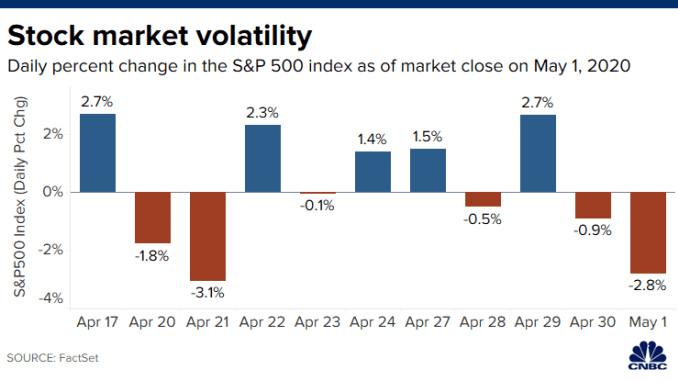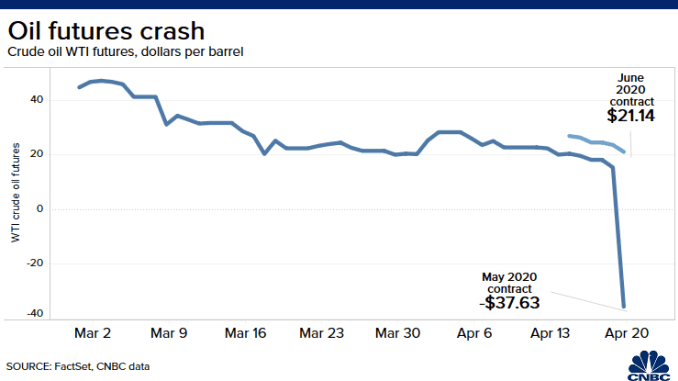Stocks fell sharply Monday, retreating after back-to-back weekly gains, as a historic decline in U.S. crude prices raised concerns about the economic damage being done by coronavirus shutdowns. A delay in funding the for the depleted small business rescue loan program also weighed on sentiment.
The Dow Jones Industrial Average closed 592.05 points lower, or 2.5%, 23,650.44. The S&P 500 slid 1.8% to 2,823.16. The Nasdaq Composite pulled back 1% to 8,560.73.
Boeing fell more than 6% to lead the Dow lower while Chevron and Exxon Mobil dropped more than 4% each. Energy, real estate and utilities were the worst-performing sectors in the S&P 500, falling more than 3% each.

The May contract for West Texas Intermediate, which expires on Tuesday, plunged more than 100% to settle at negative $37.63 per barrel, a bizarre move tied to weak demand outlook and storage capacity issues.
The negative impact on stocks from oil likely would have been worse were it not for lesser declines in oil contracts expiring during future months. WTI’s June contract slid over 15.6% to $21.09 per barrel. July’s oil contract was down 6.9%. It was a strange phenomenon that analysts chalked up to the collapse in demand for oil contracts expiring this week. Refineries don’t need the oil and are near storage capacity with most of the country shut down. The negative price means producers will pay to take this oil off their hands.
“The moves in the oil market are really just unbelievable now that we are literally running out of storage space,” Peter Boockvar, chief investment officer at Bleakley Advisory Group, said in a note. “I do believe that these types of moves is what bottoms are made of and in May and June when things start to reopen again it will go a long way in helping along with the production cuts.”

Sentiment on Wall Street was also soured by the Senate not reaching a deal on more coronavirus relief. However, the Senate set up a vote as soon as Tuesday afternoon.
Stocks got a jolt last week after a report said patients with severe virus symptoms were quickly recovering after using remdesivir, a Gilead Sciences drug. The Dow, S&P 500 and Nasdaq all rose more than 2% last week. The major averages also had their first consecutive weekly gain since February.
New York Gov. Andrew Cuomo said Sunday the state is “past the high point” of new cases, noting the infection rate has fallen along with coronavirus-related hospitalizations. Cuomo added New York will roll out antibody testing this week. In New Jersey, Gov. Phil Murphy said Saturday: “We’re flattening the curve.”
“The equity markets and bond markets in the US are telling me that my relatively optimistic outlook for the global economy is also what the markets are starting to price in,” Stephen Jen, co-founder of SLJ Macro Partners, wrote in a note. “There is now light at end of the tunnel.”
“While nobody should be under the illusion that the virus will be eradicated soon, it is important to the equity markets that we have gone through most of the known ‘rolling apexes,’ through mitigation measures,” Jen said.
Even after Monday’s sharp decline, the Dow was 29% above a March 23 intraday low while the S&P 500 had bounced 28.8%.
But while the market may be pricing in an improvement in the virus outbreak, recent economic data has been dismal. Over the past month, 22 million jobs have been lost, weekly unemployment claims numbers from the Labor Department showed.
The number of coronavirus related deaths have also risen to more than 165,000 globally, according to Johns Hopkins University. In the U.S., the death toll has risen to over 41,000.
“The worst is yet to come for capital markets,” said Komal Sri-Kumar, president of Sri-Kumar Global Strategies. “Eventually, you’re going to test another low and that is when it will be the time for you to close your eyes and say this is the start of a long term rally again.”
